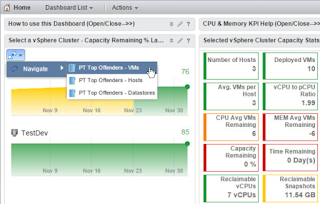VMware vROps - Oversized VMs Dashboard

Oversized VMs in a virtualized environment lead to wasted resources and lower consolidation ratios. This also introduces performance problems such as CPU Contention and Ready as the workload utilization increases. The Oversized VMs Dashboard will help you find and analyze VM candidates that could be down-sized and enable your organization to get more with less. The goal of this dashboard is to empower virtualization admins to find over-sized VMs, analyze their historical resource utilization, provide sizing recommendations, and back it up with evidence in order to reclaim unused resources. I know what you're going to say: "easier said than done." Yes, the battle to reclaim resources is mostly a lost one already unless you can educate your users upfront and prevent over-sizing to begin with. If you still want to endeavor on that journey, then I highly recommend you read a VMware White Paper entitled VM Right-Sizing Best Practices Guide by VMware's Jason Garudre...



